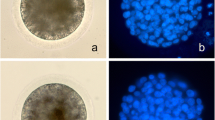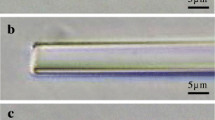Abstract
Purpose
We investigated the effect of electrical stimulation on rabbit oocyte activation using intracytoplasmic sperm injection (ICSI) to determine whether viable offspring can be produced from deceased rabbit sperm using ICSI.
Methods
Sperm were collected from a heterozygote GFP male rabbit 5 h after sacrifice and cryopreserved in liquid nitrogen. Mature oocytes were fertilized using ICSI. A series of electrical pulse procedures were used to activate oocytes before and/or after ICSI. Following ICSI, zygotes were cultured in B2 medium for 4 days or transferred into the oviducts of recipient rabbits at the 2- or 4-cell stage.
Results
The blastocyst formation rate was significantly greater in oocytes that received one or two pulses prior to ICSI compared to controls and other electrically stimulated groups. In the single pulse before ICSI group, 23 % of the blastocysts expressed GFP, which was significantly greater than all other groups. However, those that received treatment before and after, or just following ICSI, showed a significant decrease in embryo survival. Finally, embryos from the single pulse before ICSI group were transferred into recipient female rabbits and a full-term kit was successfully delivered.
Conclusions
One pulse of electrical stimulation prior to sperm injection was an effective method to activate rabbit oocytes for fertilization. Sperm collected from a deceased rabbit is able to produce viable embryos through ISCI that are capable of normal fetal and kit development.




Similar content being viewed by others
References
Iritani A, Hosoi Y. Microfertilization by various methods in mammalian species. Prog Clin Biol Res. 1989;294:145–9.
Goto K, Kinoshita A, Takuma Y, Ogawa K. Fertilisation of bovine oocytes by the injection of immobilised, killed spermatozoa. Vet Rec. 1990;127(21):517–20.
Palermo G, Joris H, Devroey P, Van Steirteghem AC. Pregnancies after intracytoplasmic injection of single spermatozoon into an oocyte. Lancet. 1992;340(8810):17–8.
Kimura Y, Yanagimachi R. Intracytoplasmic sperm injection in the mouse. Biol Reprod. 1995;52(4):709–20.
Cochran R, Meintjes M, Reggio B, Hylan D, Carter J, Pinto C, et al. Production of live foals from sperm-injected oocytes harvested from pregnant mares. J Reprod Fertil Suppl. 2000;56:503–12.
Catt SL, Catt JW, Gomez MC, Maxwell WM, Evans G. Birth of a male lamb derived from an in vitro matured oocyte fertilised by intracytoplasmic injection of a single presumptive male sperm. Vet Rec. 1996;139(20):494–5.
Kolbe T, Holtz W. Birth of a piglet derived from an oocyte fertilized by intracytoplasmic sperm injection (ICSI). Anim Reprod Sci. 2000;64(1–2):97–101.
Chan AW, Luetjens CM, Dominko T, Ramalho-Santos J, Simerly CR, Hewitson L, et al. Foreign DNA transmission by ICSI: injection of spermatozoa bound with exogenous DNA results in embryonic GFP expression and live rhesus monkey births. Mol Hum Reprod. 2000;6(1):26–33.
Jones J, Horne G, Fitzgerald C. Who needs ICSI? A nationwide UK survey on ICSI use. Hum Fertil (Camb). 2012;15(3):144–9.
Keefer CL. Fertilization by sperm injection in the rabbit. Gamete Res. 1989;22(1):59–69.
Hoshi K, Yazawa H, Yanagida K, Sato A. Microinsemination of rabbit oocytes with heat-treated sperm: embryonic development. Arch Androl. 1992;29(3):233–7.
Zheng YL, Jiang MX, Zhang YL, Sun QY, Chen DY. Effects of oocyte age, cumulus cells and injection methods on in vitro development of intracytoplasmic sperm injection rabbit embryos. Zygote. 2004;12(1):75–80.
Ogonuki N, Inoue K, Miki H, Mochida K, Hatori M, Okada H, et al. Differential development of rabbit embryos following microinsemination with sperm and spermatids. Mol Reprod Dev. 2005;72(3):411–7.
Li QY, Hou J, Chen YF, An XR. Full-term development of rabbit embryos produced by ICSI with sperm frozen in liquid nitrogen without cryoprotectants. Reprod Domest Anim. 2010;45(4):717–22.
Collas P, Robl JM. Factors affecting the efficiency of nuclear transplantation in the rabbit embryo. Biol Reprod. 1990;43(5):877–84.
Ozil JP. The parthenogenetic development of rabbit oocytes after repetitive pulsatile electrical stimulation. Development. 1990;109(1):117–27.
Staessen C, Janssenswillen C, De Clerck E, Van Steirteghem A. Controlled comparison of commercial media for human in-vitro fertilization: Menezo B2 medium versus Medi-Cult universal and BM1 medium. Hum Reprod. 1998;13(9):2548–54.
Stranzinger GF, Maurer RR, Paufler SK. Fertility of frozen rabbit semen. J Reprod Fertil. 1971;24(1):111–3.
Deng M, Yang XJ. Full term development of rabbit oocytes fertilized by intracytoplasmic sperm injection. Mol Reprod Dev. 2001;59(1):38–43.
Chen H. Fertilization by intractoplasmic sperm injection in rabbit oocytes. Acta Laboratorium Animal is Scientia Sinica. 2008;16(4):251–3.
Ozil JP, Huneau D. Activation of rabbit oocytes: the impact of the Ca2+ signal regime on development. Development. 2001;128(6):917–28.
Tesarik J. Calcium in oocyte maturation. How the spermatozoon awakens the oocyte: lessons from intracytoplasmic sperm injection. Hum Reprod. 1994;9(6):977–8.
Kline D, Kline JT. Repetitive calcium transients and the role of calcium in exocytosis and cell cycle activation in the mouse egg. Dev Biol. 1992;149(1):80–9.
Hwang S, Lee E, Yoon J, Yoon BK, Lee JH, Choi D. Effects of electric stimulation on bovine oocyte activation and embryo development in intracytoplasmic sperm injection procedure. J Assist Reprod Genet. 2000;17(6):310–4.
Liu JL, Kusakabe H, Chang CC, Suzuki H, Schmidt DW, Julian M, et al. Freeze-dried sperm fertilization leads to full-term development in rabbits. Biol Reprod. 2004;70(6):1776–81.
Zheng Y. Placental abnormalities in animal cloning. Chem Life. 2011;31(2):317–20.
Tanaka S, Oda M, Toyoshima Y, Wakayama T, Tanaka M, Yoshida N, et al. Placentomegaly in cloned mouse concepti caused by expansion of the spongiotrophoblast layer. Biol Reprod. 2001;65(6):1813–21.
Ravelich SR, Breier BH, Reddy S, Keelan JA, Wells DN, Peterson AJ, et al. Insulin-like growth factor-I and binding proteins 1, 2, and 3 in bovine nuclear transfer pregnancies. Biol Reprod. 2004;70(2):430–8.
Inoue K, Wakao H, Ogonuki N, Miki H, Seino K, Nambu-Wakao R, et al. Generation of cloned mice by direct nuclear transfer from natural killer T cells. Curr Biol. 2005;15(12):1114–8.
Acknowledgments
The study was supported by grants from the Natural Science Foundation of China (Nos. 81170756, 31101048), the Shanghai Natural Science Funding (Nos. 10140901700, 11140901600, 11ZR1418800) and the National Transgenic Foundation of China (2011ZX08008-003).
Author information
Authors and Affiliations
Corresponding authors
Additional information
Capsule Suitable electrical stimulation on rabbit oocytes could increase the fertilization and embryo development when the sperm from deceased rabbit were used for ICSI, and sperm from deceased rabbit are capable of full term and kit development.
Rights and permissions
About this article
Cite this article
Zhou, X., Yin, M., Jiang, W. et al. Electrical activation of rabbit oocytes increases fertilization and embryo development by intracytoplasmic sperm injection using sperm from deceased male. J Assist Reprod Genet 30, 1605–1610 (2013). https://doi.org/10.1007/s10815-013-0113-z
Received:
Accepted:
Published:
Issue Date:
DOI: https://doi.org/10.1007/s10815-013-0113-z




